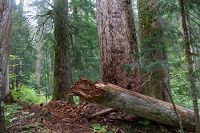Morticulture: Forests of the living dead
NSF Discoveries reports on a 200-year-long study to monitor the decompotion of trees at the H.J. Andrews Long-Term Ecological Research site in Oregon led by biologist Mark Harmon of Oregon State University.
"...In the mid-1980s, Harmon and other scientists dragged hundreds of logs with different diameters into an old-growth Douglas fir forest at NSF's H.J. Andrews Long-Term Ecological Research (LTER) site in Oregon.
They watched as beetles moved into the dead logs. "Beetles foster decomposition through the fungal spores they track deep into the logs," says Harmon. "The fungi use the toughest part of the wood as food. In doing so, they help release nutrients into the soil."
Over 30 years of observation, scientists estimate that hundreds of species have moved in and called the dead trees home.
Despite the expectation that all dead wood would decompose at a slow and steady rate, Harmon has found that tree rotting is a unique process. It depends on the tree species, the fungi that take up residence, the moisture content, the geographic location and the size of the tree..."
Continue on reading about this work here.
News Source:
READ MORE from NSF >>
News Category:
RESEARCH
Explore Further


